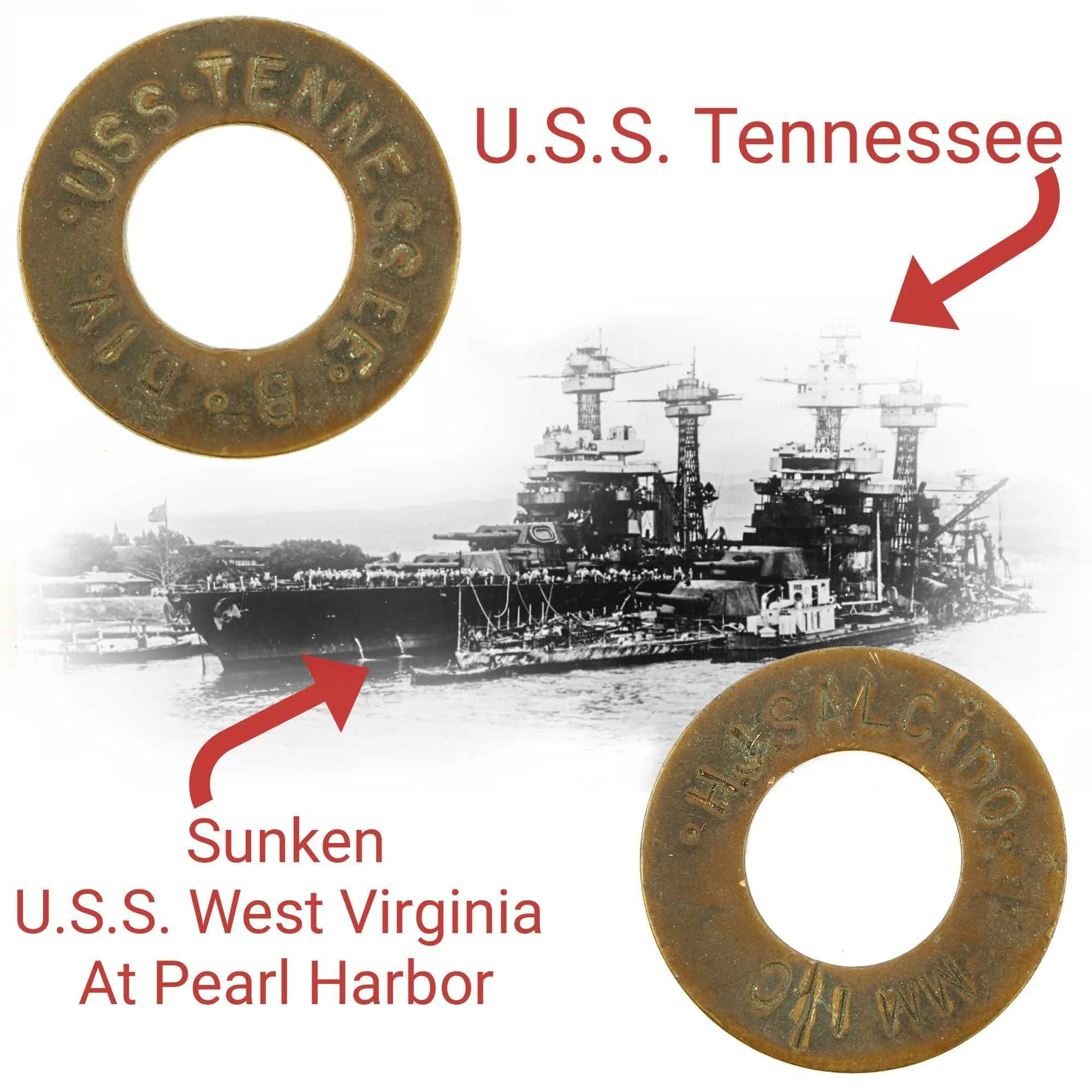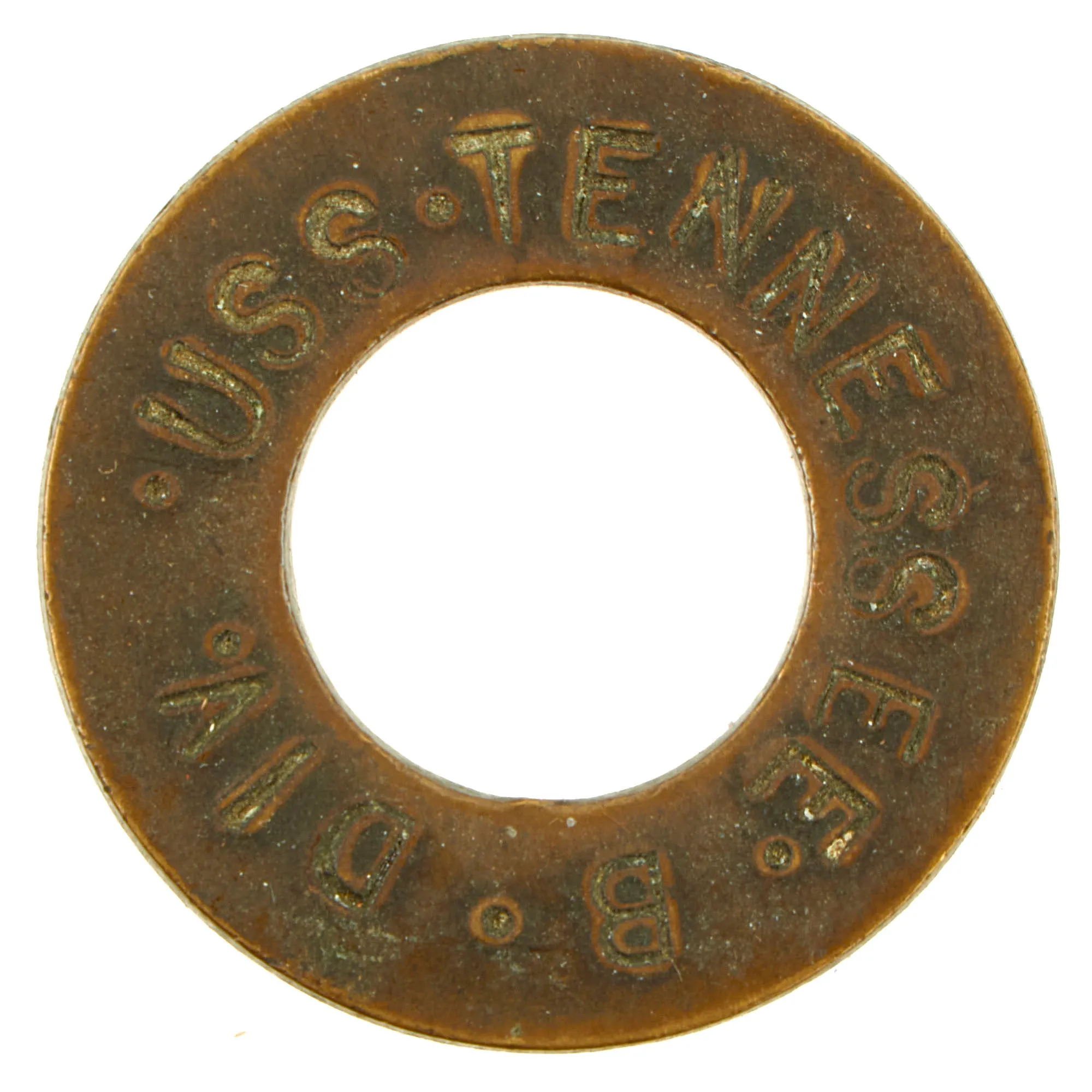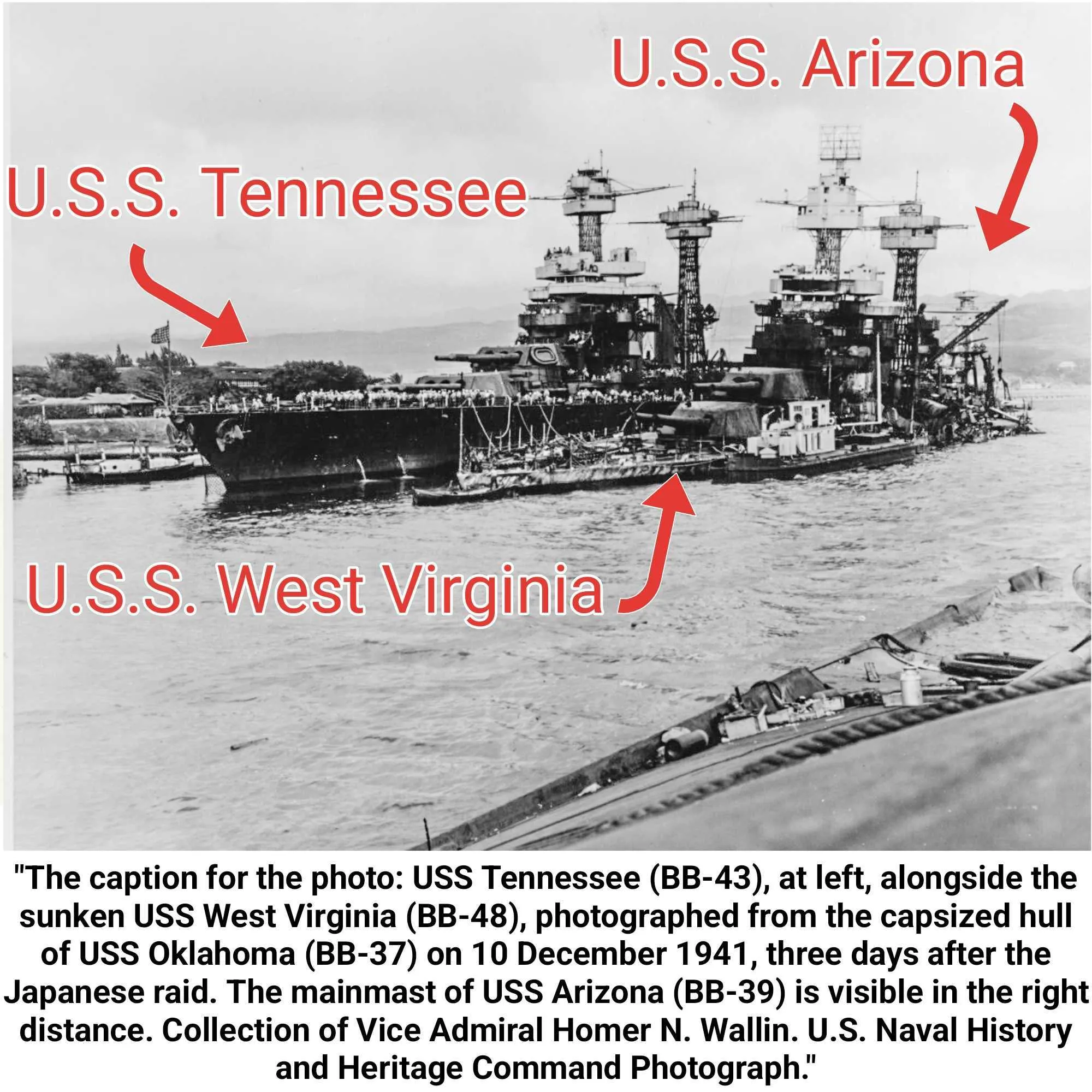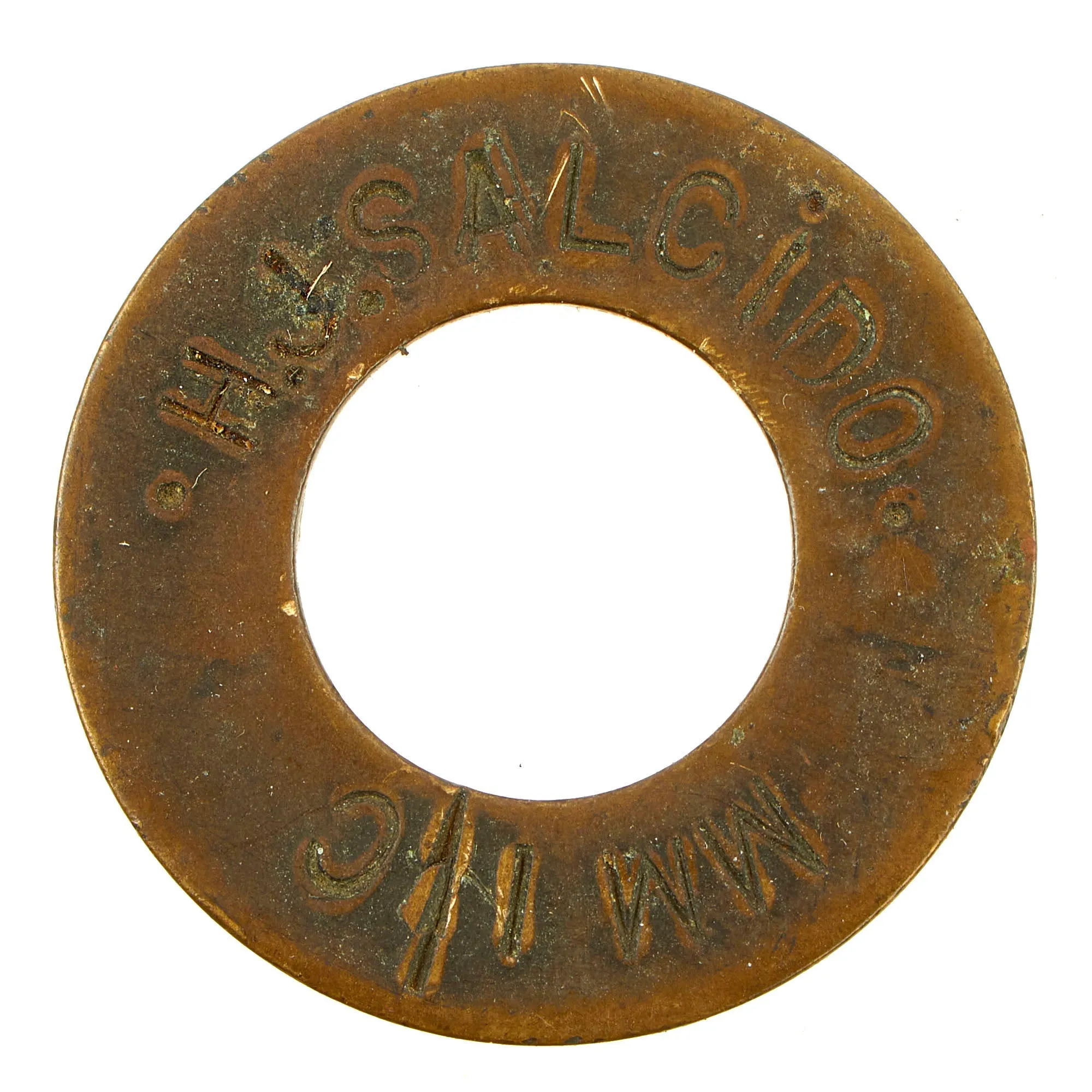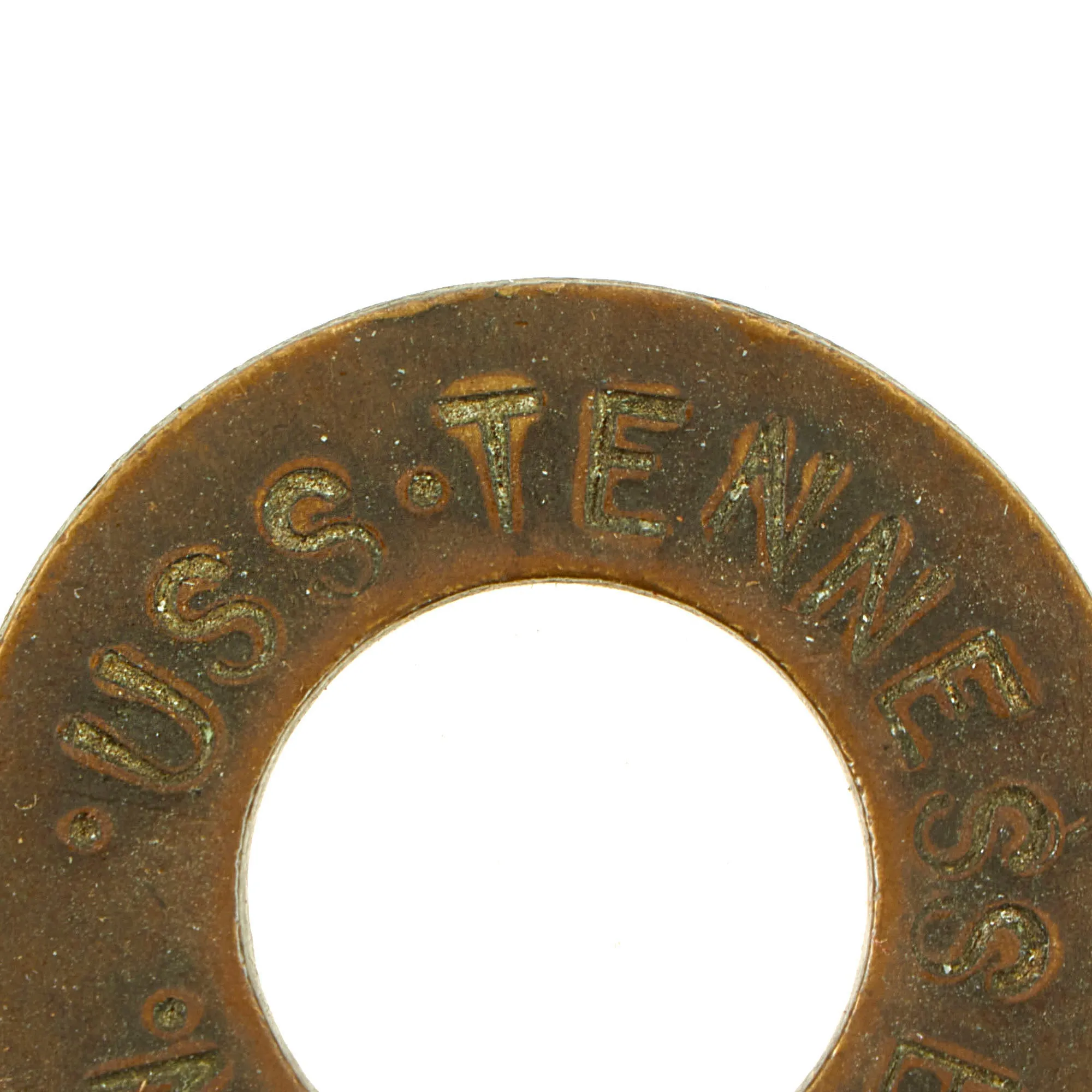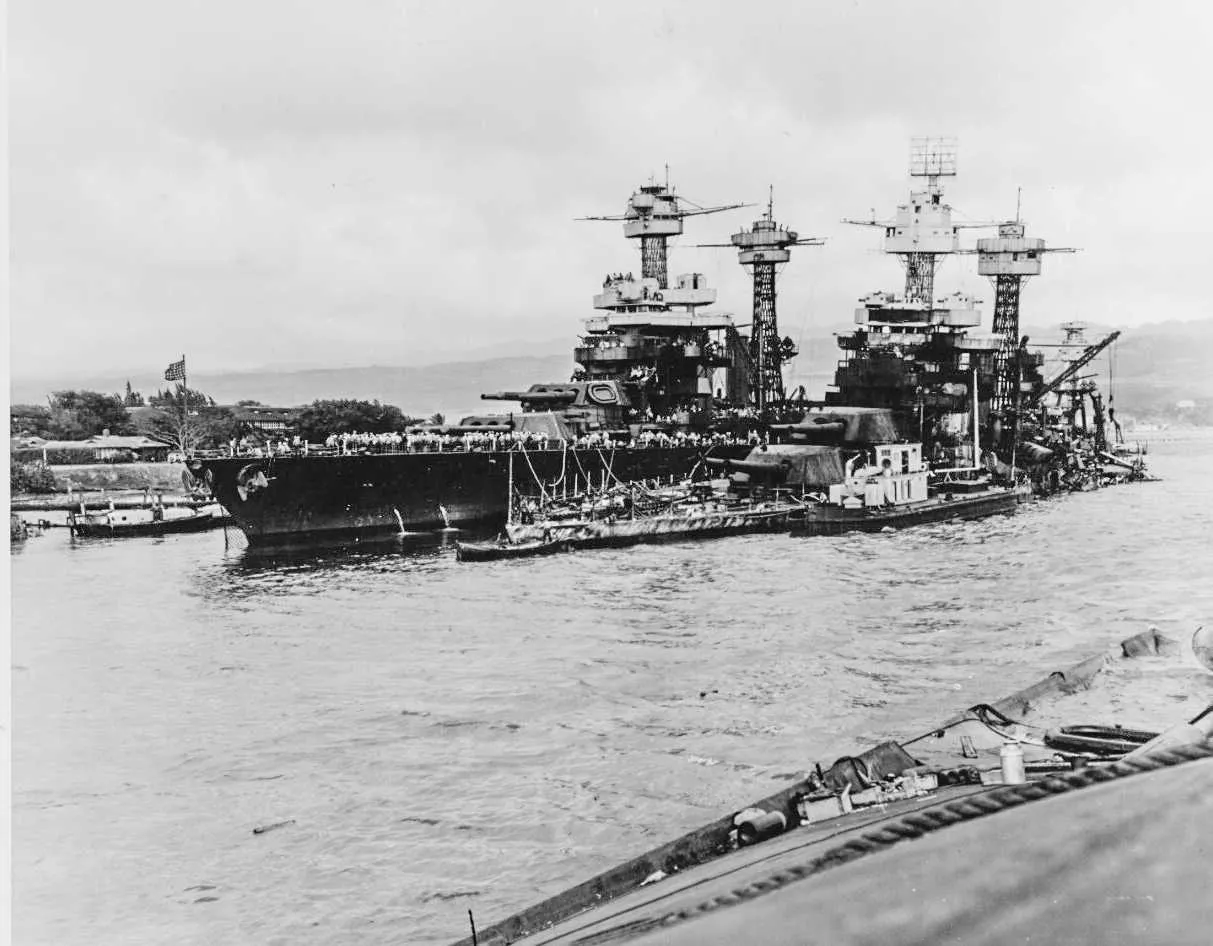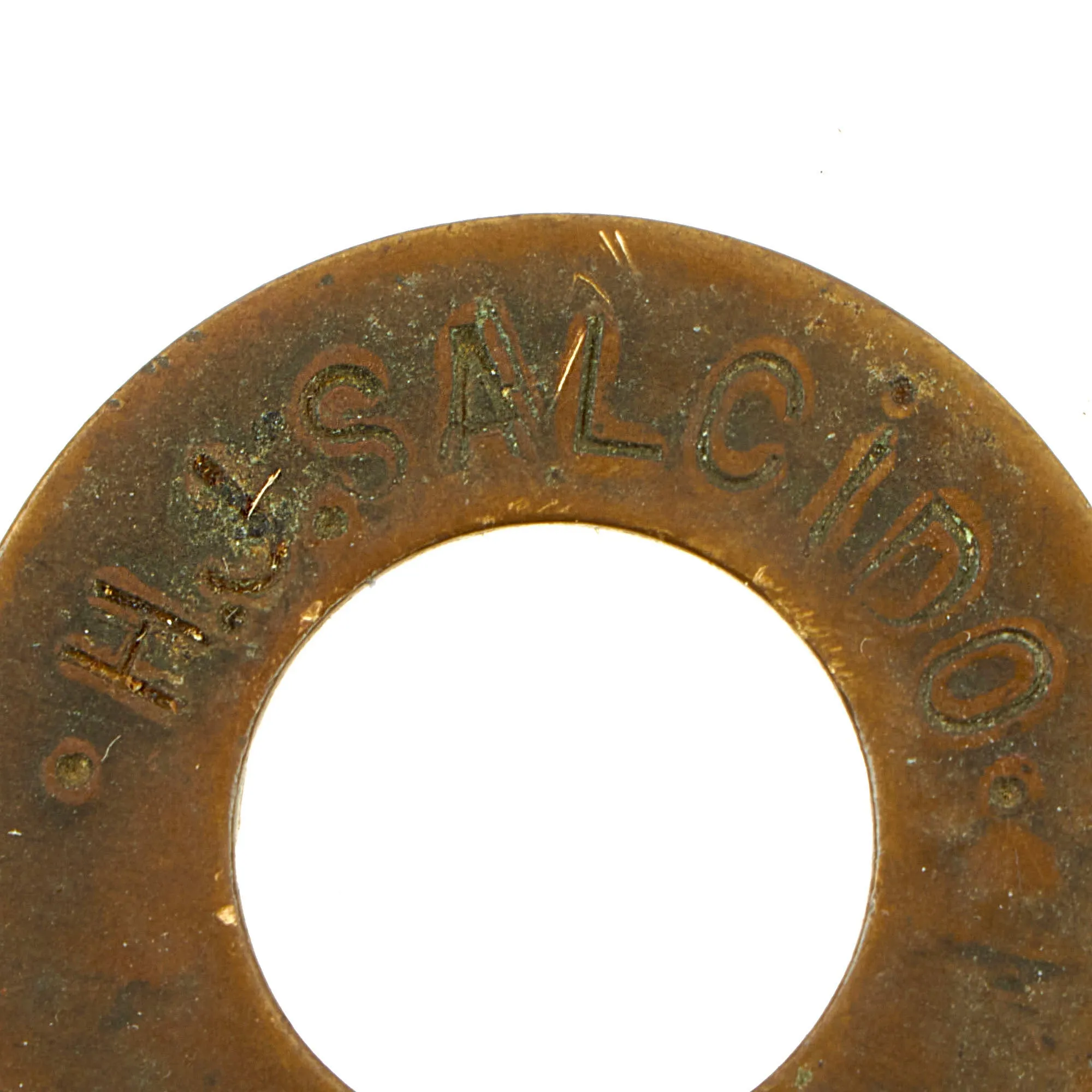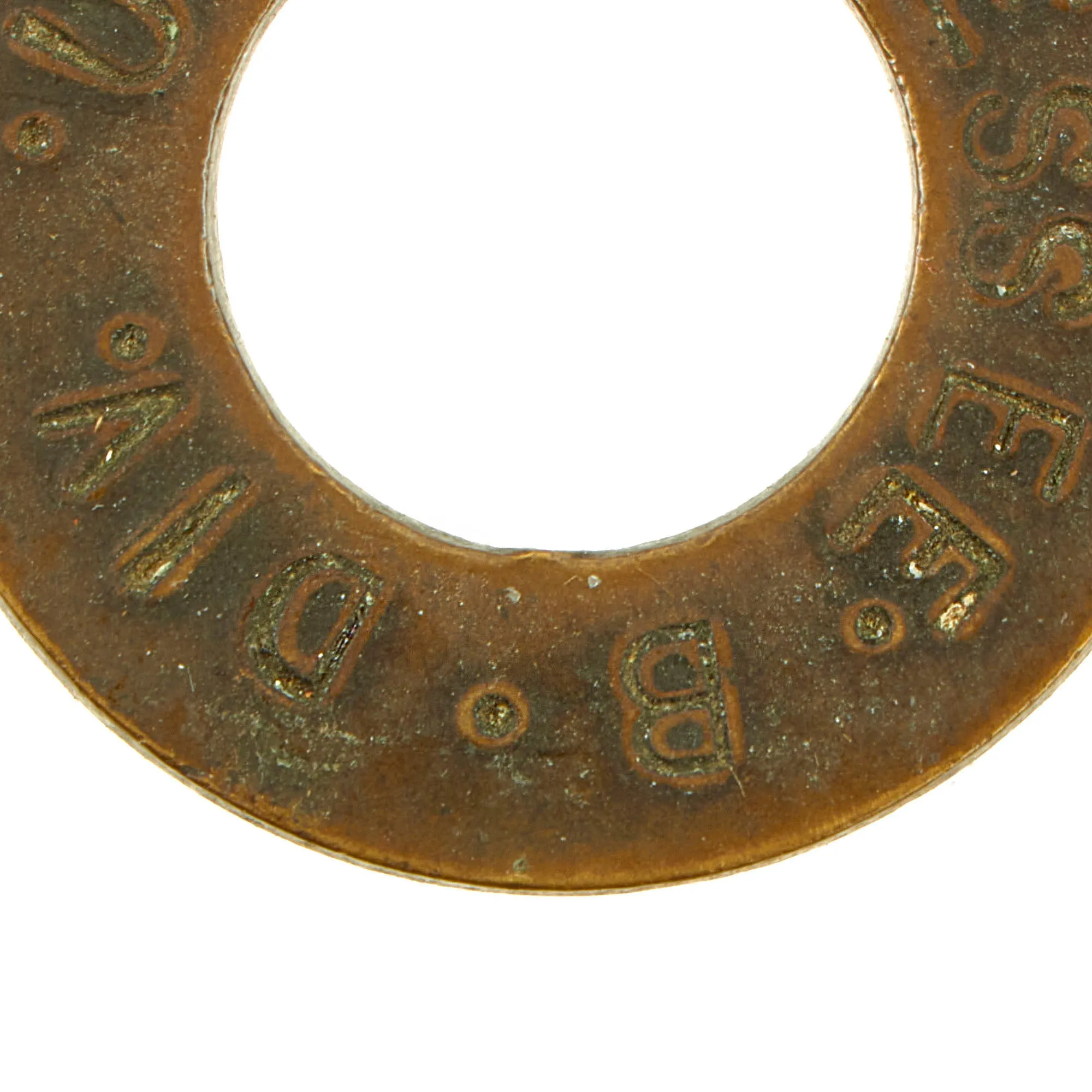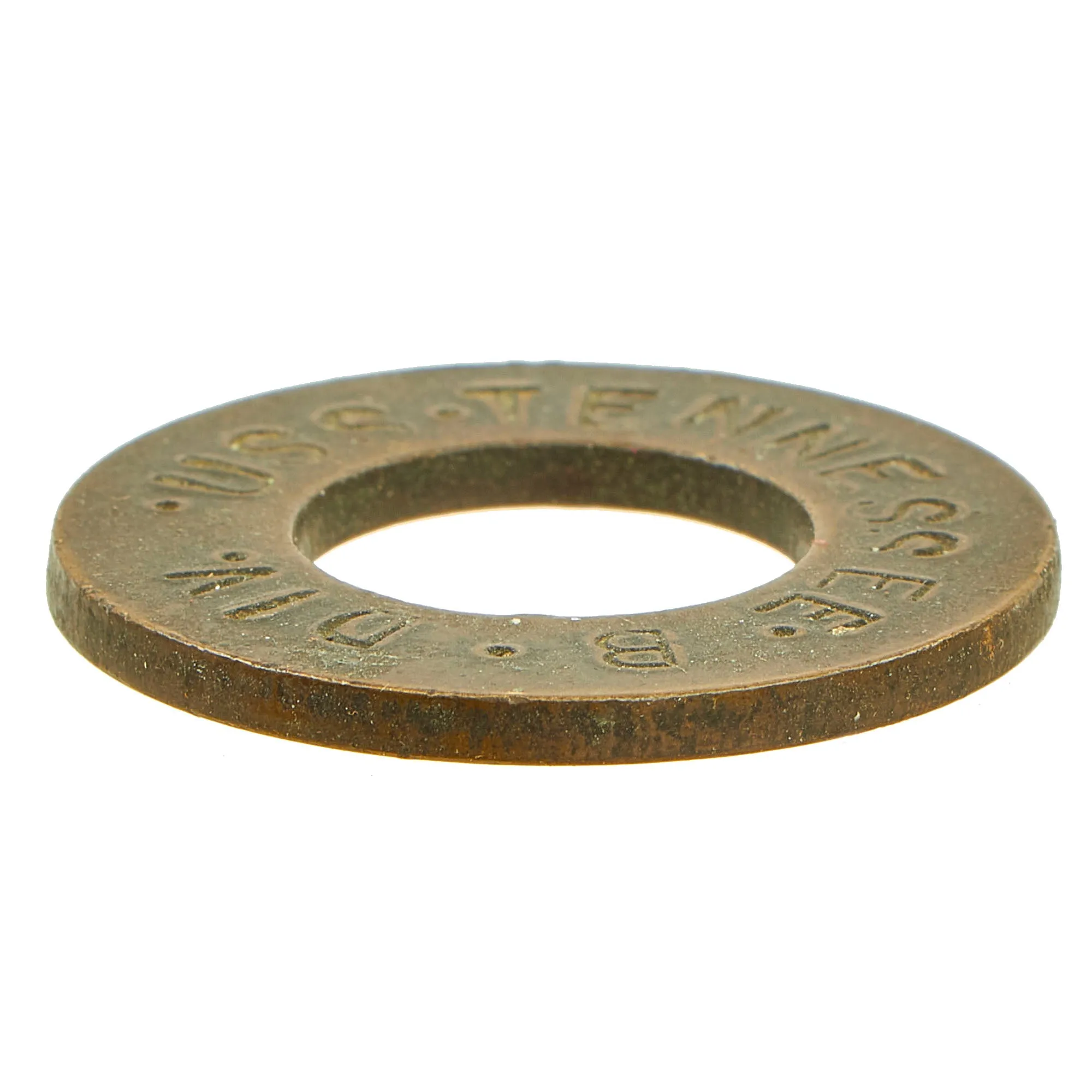Original Item: Only One Available. Machinist Mate 1st Class Hector J. Salcido arrived on the USS Tennessee during the “repair, training and modernization” process in October of 1942 and served aboard for the duration of the war. It was at this time we believe that MM1 Salcido took this brass washer as a memento or possibly even a “good luck charm” as he was stationed on a ship that survived the horrific attack. He had USS TENNESSEE B DIV on one side with H.J. SALCIDO MM1/C on the opposite. The brass washer measures approximately 1 ⅜” in diameter with all markings still visible and clear as they were deeply stamped into the brass.
Naval brass is known to be a tough metal alloy. It can hold its form under extreme heats, extreme pressures, and through severe wear and tear. This makes it an ideal material from which to create ships. Ships see some of the most severe conditions, so they require a metal that can hold its ground and integrity. This explains why the washer has remained in remarkable condition during the attack and the decades before.
A lovely memento that comes more than ready for further research and display.
On 7 December 1941, the Japanese attacked Pearl Harbor, "A Date That Will Live In Infamy" and the USS Tennessee was moored along Battleship Row, to the southeast of Ford Island. The battleship West Virginia was tied up alongside, Maryland was ahead with Oklahoma abreast, and Arizona was astern. The first Japanese attack arrived at about 07:55, prompting Tennessee's crew to go to general quarters; it took some five minutes for the men to get the ship's anti-aircraft guns into action. The ship received orders to get underway to respond to the attack, but before the crew got steam up in her boilers, she was trapped as the other battleships around her received crippling damage. West Virginia was torpedoed and sunk and Oklahoma capsized after being torpedoed. Shortly thereafter, dive bombers arrived overhead and fighters strafed the ships' anti-aircraft batteries. Arizona exploded after being hit by an armor-piercing bomb that detonated her magazines, spilling burning fuel oil into the water. The explosion also showered burning oil over Tennessee's stern, and she was quickly surrounded by fire, which was augmented by oil leaking from West Virginia.
At 08:20, Japanese bombers hit Tennessee twice; both bombs were converted large-caliber naval shells, the same type that had destroyed Arizona, but neither detonated properly. The first partially penetrated the roof of turret III, failing to explode but sending fragments into the turret that disabled one of the guns. The second bomb hit turret II's center gun barrel and exploded, sending bomb fragments flying; one of these fragments killed the captain of West Virginia, Mervyn S. Bennion, who had walked out to the open bridge. The blast disabled all three guns of that turret. Neither bomb inflicted serious damage, but the ship's magazines were flooded to avoid the risk of the fires raging aboard and around the vessel from spreading to them and igniting the propellant charges stored there. By 10:30 the crew had suppressed the fires aboard the ship, though oil still burned in the water around the ship for another two days. In an effort to push the burning oil away from the ship, she turned her screws at a speed of 5 knots (9.3 km/h; 5.8 mph). In the course of the battle, Tennessee's anti-aircraft gunners were credited with shooting down or assisting in the destruction of five Japanese aircraft.
Tennessee remained trapped by the sunken battleships around her until Maryland could be pulled free on 9 December; she had been wedged into the dock by Oklahoma when she capsized and sank. The quays to which Tennessee had been moored had to be demolished to allow her to be towed out, as the sunken West Virginia had similarly forced her into them. This work was completed by 16 December, allowing the ship to be pulled slowly out past West Virginia and Oklahoma. She was then taken into the Pearl Harbor Navy Yard for repairs. The fires had warped her hull plates, damaged seams, and loosened rivets, all of which needed to be repaired before she could get underway for permanent repairs. Once the hull was again watertight and her III turret received a patch cover, she got underway for Puget Sound for permanent repairs on 20 December, in company with Maryland and Pennsylvania, both of which had also received only minimal damage in the attack. The three battleships were escorted by four destroyers.
With the change of naval battles from conventional surface-ship actions to long-range duels between fast carrier striking forces, the older battleships — Tennessee and her kin – were simply too slow to keep up with the carriers. The Tennessee spent some time with TF 1, which patrolled areas of the Pacific in the expectation that part of the Japanese fleet might attempt an "end run" raid on the West Coast of the United States.
On 1 August, the Tennessee again sailed from San Francisco with TF 1. After a week of exercises, the battleships joined the Hornet on her way to the $3 to support the invasion of Guadalcanal, and then escorted the carrier as far as Pearl Harbor. Arriving at Pearl Harbor on 14 August, the Tennessee returned to Puget Sound on the 27th for modernization. The reason Tennessee and her sisters in TF1 did not sortie with the task force bound for invasion of Guadalcanal was less to do with her speed than with her thirst for fuel. The old battleships had a vast appetite for fuel and there were limits on the Navy's ability to transport and store bunker oil in the Pacific. During the invasion of Guadalcanal there were just seven tankers to sustain the flow of oil in the theater, which was crippling operations owing to what fuel hogs the old battleships were. Task Force 1, including its escorts, burned three hundred thousand barrels of oil in a month. This was the total oil storage capacity of the Pacific in early 1942. A carrier task force was almost as thirsty and the Navy only had enough fuel to operate either its carriers or battleships. With the lessons of the Pearl Harbor attack fresh in the mind of every commander, there was no doubt that between the two choices the carriers would take precedence. For this reason, Admiral Nimitz vetoed any proposal to operate the old battleships out of Pearl.
By the time Tennessee emerged from Puget Sound Navy Yard on 7 May 1943, she bore virtually no resemblance to her former self. Her appearance was nearly identical to that of the West Virginia and the California (which were rebuilt after the Pearl Harbor attack to resemble the South Dakota-class battleships). The upgrade work increased protection against torpedoes, internal compartmentation was rearranged and improved, a new compact superstructure designed to provide control facilities while offering less interference to antiaircraft guns was installed, and upgraded antiaircraft guns and fire-control radars were installed. Her original twin funnels were combined into a single funnel faired into the superstructure tower as with the South Dakota class. The original secondary battery of 5-inch (127-mm)/51-cal guns and the antiaircraft battery of 5-inch (127-mm)/25-cal guns was replaced by 16 5-inch / 38calibre guns in eight twin mounts controlled by four Mk 37 directors.
As part of the new policy of the Two-Ocean-Navy, American battleships had been designed within a beam constraint of 108 feet (33 m) in order to pass through the locks of the Panama Canal. After being similarly rebuilt, the Tennessee, the California, and the West Virginia were broadened to 114 feet (35 m) wide, limiting their use in wartime to the Pacific Theater of Operations.
1943 The Aleutian Islands and Tarawa
On 31 May 1943, she headed to Alaska and a fight in the Aleutian Islands. While providing sea protection to the landing forces was a job of major importance, the Japanese Navy did not challenge the American forces. Instead, Tennessee found her duty was to use her formidable guns to support the ground troops by bombarding enemy land positions. It was a task she would perform throughout the war. The Aleutian Islands back in American hands, she headed back home reaching San Francisco on 31 August. Tennessee then began an intensive period of training.
Tennessee's next mission was to support the attack of Betio in the Battle of Tarawa. From 20–23 November 1943, the main fighting went on, supported by Tennessee's guns. Tennessee also joined other ships in the sinking of Japanese submarine I-35. At dusk on 3 December, Tennessee departed the area for Pearl Harbor and then San Francisco. There she was quickly repainted in a "dazzle" camouflage scheme.
On 29 December 1943, Tennessee began intensive bombardment practice, pounding San Clemente Island in rehearsal for the invasion of the Marshall Islands.
1944 Marshall Islands
In the early morning of 13 January 1944, Tennessee set her course for Hawaii with Task Unit 58.5.1 (TU 58.5.1) and anchored in Lahaina Roads off Maui on 21 January. That day, the ship was inspected by a group headed by Undersecretary of the Navy James Forrestal. On 29 January, Tennessee, with Forrestal on board, headed for the Marshalls.
Arriving 31 January 1944, Tennessee bombarded the islands, helping the ground forces and destroying numerous shore batteries and detonating a Japanese ammunition dump on Namur. During nighttime, Army troops called several times for illumination. Destroyers played their searchlights over Japanese-held areas, while Tennessee's 5 inch (127 mm) guns fired large numbers of star shells. At times, Tennessee was firing at such a short range that, during the afternoon of 20 February, she was able to attack beach defenses with her 40 mm guns.
Bismarck Archipelago
On 23 February 1944, Tennessee sailed for Majuro. Here, she joined New Mexico, Mississippi, and Idaho. Under the command of Rear Admiral Robert M. Griffin, the battleships sortied from Majuro on 15 March with two escort carriers and a screen of 15 destroyers.
Their objective was the Japanese air and naval base at Kavieng, at the northern end of New Ireland. The Bismarck Archipelago, the two large islands of New Britain and New Ireland, lie just to the east of New Guinea. Rabaul, the by-now legendary Japanese operating base, is at the eastern end of New Britain, just across a narrow channel from New Ireland. About 240 mi (390 km) northwest of Rabaul, across the Bismarck Sea, is the small Admiralty Islands group. Once again, Tennessee's big guns pounded away at Japanese positions, destroying shore batteries and helping the ground forces rout the enemy as well as shelling the Japanese airfield and shore facilities.
Mariana Islands
Operation Forager, the assault on the Mariana Islands, was planned as a two-pronged thrust. Vice Admiral Richmond K. Turner's TF 51 was organized into a Northern Attack Force (TF 52), under his command, and a Southern Attack Force (TF 53) under Rear Admiral Richard L. Conolly. The Northern Attack Force assembled at Hawaii in mid-May 1944. After rehearsals off Maui and Kahoolawe, Fire Support Group One sailed for Kwajalein while the transports staged at Eniwetok. On 10 June, Tennessee and her task group departed Kwajalein, bound for Saipan.
At Saipan, in addition to providing protection for the fleet, Tennessee began a methodical bombardment of the selected landing area, the southern portion of Saipan's west coast, in support of minesweepers carrying out an assault sweep on the landing zone.
Underwater demolition teams (UDT) approached the beach in small craft to reconnoiter the landing beaches and to plant radar beacons which would provide reference points to the next day's landing. Tennessee closed to 3,000 yd (2,740 m) of Agingan Point and opened up with 14 in (360 mm), 5 inch (127 mm), and 40 mm batteries. Some smoldering powder grains from the 5 inch (127 mm) guns fell on the port side of the battleship's quarterdeck and burst into flame, but were quickly extinguished.
Japanese guns dropped shells near the UDTs as mortars and machine guns joined in and projectile splashes began to appear near the supporting ships as batteries on nearby Tinian opened fire. Cleveland was straddled, and California and Braine took hits. Tennessee aimed counterbattery fire at the defenders who were opposing the UDTs, and her turret guns fired at Tinian. Shortly before noon, she moved to the northwest to bombard Japanese fortifications on Afetna Point, near the center of the landing zone.
Tennessee's assault station was off the southern end of the landing beach. During the first wave's approach, her guns enfiladed that end of the objective to prepare the way for the right-hand elements of the 4th Division. She checked fire as the troops neared the beach, resuming it a few minutes later as the Marines fought to establish themselves ashore. Japanese 4.7 in (120 mm) field guns, emplaced in a cave on Tinian, opened on Tennessee. The battleship commenced counterbattery fire, but the third enemy salvo scored three hits, all of which burst on impact. One projectile knocked out a 5 inch (127 mm) twin gun mount; the second struck the ship's side, while the third tore a hole in the after portion of main deck and sprayed fragments into the wardroom below. An intense fire inside the disabled gun mount was subdued in two minutes by repair parties and men from nearby gun crews; the hit to the hull damaged external blister plating, but was prevented from inflicting further damage by the battleship's heavy belt armor. Eight men were killed by projectile fragments, while 26 more were wounded by fragments and flash burns.
Tennessee's damages did not prevent her from delivering call fire to help break up a developing Japanese counterattack near Agingan Point before leaving the firing line to make emergency repairs. During the afternoon and night, she took station to screen assembled transports. Four Japanese dive bombers attacked nearby ships at 1846, and Tennessee's 5 inch (127 mm) guns briefly engaged them but claimed no hits. That evening, Tennessee buried her dead. Tokyo radio claimed victory in the battle for Saipan, stating that they had sunk a battleship which they identified as "probably the New Jersey." The "sunken" Tennessee returned to Saipan Channel early the next day. Several Japanese counterattacks had been stopped during the night, and Tennessee's supporting fire assisted the marines in organizing and consolidating their beachhead.
On the night of 22 June, Tennessee got underway for Eniwetok where Hector repaired her battle damage as the fight for Saipan ground to its end on 9 July. Her next destination was Guam. On 20 July, she joined in a systematic bombardment begun on 8 July, which was carefully planned to soften up the enemy's defenses while avoiding harm to the island's friendly Chamorro population.
Palau Islands
The Palaus were to be Tennessee's next objective. This group was not an atoll, but an elongated cluster of islands just north of the equator and at the western end of the Caroline Islands.
The battle for Peleliu was to be one of the most bitter of the Pacific war, and organized resistance was not eliminated until November, at a heavy cost in lives. Tennessee's target was the smaller island of Angaur, a few miles south of Peleliu. On the morning of 12 September, Tennessee and Pennsylvania, with four light cruisers and five destroyers, began a prolonged bombardment as carrier aircraft did their share.
A prominent masonry lighthouse on the west coast of Angaur was ordered destroyed to keep the Japanese from using it as a gunfire observation point. Twelve 14 in (360 mm) rounds were aimed at it, scarring the area and scoring three hits, but the tower remained standing. Other targets absorbed Tennessee's attention for the next three days. Tennessee stood by off Peleliu during the morning of 15 September in case her guns should be needed to assist the assault landing. When this work was completed, she returned on the evening of 16 September to finish off the stubborn tower before the next morning's scheduled landings.
Battle of Leyte Gulf
Tennessee weighed anchor on 12 October and set her course for Leyte Gulf, Under the supreme command of General MacArthur, Vice Admiral Thomas Kinkaid's 7th Fleet carried two Army corps toward the invasion area.
At 0609 on the morning of 18 October, Tennessee, with her fire-support unit, entered the channel between Homonhon and Dinagat islands. Paravanes streamed from her bows, and Marines were stationed in her upperworks to sink or explode floating mines. The minesweepers continued their work as the heavy ships moved slowly up Leyte Gulf.
The landings were scheduled for 20 October, and at 0600, Tennessee opened neutralization fire on the beaches. Tennessee continued her work off the beachhead until her fire support was no longer required and the increasing tempo of Japanese air activity in the area required her to place herself where her antiaircraft guns could assist in the defense of the assembled transports and cargo ships.
In the evening of 21 October, while lying dead in the water in a smoke screen laid to protect the shipping from attacking planes, Tennessee was rammed near the stern by the transport War Hawk. No one was injured, and the battleship's tough hull was little harmed, but her orders for a night fire-support mission were canceled.
Battle of Surigao Strait
While Tennessee had been working Leyte, the Japanese Imperial General Headquarters had noted the scale of the operation being mounted and had decided to make that island the focus of a decisive naval counterstroke – the Battle of Leyte Gulf. Under the Japanese plan, dictated by a combination of geography, logistics, and the lack of adequate carrier aviation, four widely separated forces were to converge on the area of Leyte Gulf in an effort to destroy, at whatever cost, the American invasion force. A relatively small force (two battleships Fusō and Yamashiro, one heavy cruiser and four destroyers), commanded by Vice Admiral Shoji Nishimura, turned to the south of Palawan and crossed the Sulu Sea to pass between Mindanao and Leyte. Nishimura's force would meet a number of assorted American ships, Tennessee among them, in the Battle of Surigao Strait.
As they passed the cape of Panaon Island on the evening of 24 October and morning of the 25th, the Japanese forces ran into a deadly trap set for them by the American 7th Fleet Support Force. Rear Admiral Jesse Oldendorf had six battleships (Mississippi, Maryland, West Virginia, Tennessee, California, and Pennsylvania, all but Mississippi having been resurrected from Pearl Harbor), eight cruisers (heavy cruisers Louisville, serving as the cruisers' (flagship), Portland, Minneapolis and HMAS Shropshire, and light cruisers Denver, Columbia, Phoenix, Boise), 28 destroyers and 39 PT boats.
Onboard Tennessee, observers had seen distant flashes of gunfire, star shells and searchlights as the torpedo boats and destroyers engaged the Japanese. Soon explosions could be heard. At 0302, the battleship's radar picked up Nishimura'a approach at nearly 44,000 yd (40,000 m) and began to track the lead ship. This was the flagship, Yamashiro. With the cruiser Mogami and the destroyer Shigure, she was all that remained of the first Japanese force. At 0351, Oldendorf ordered the flanking cruisers to open fire, and at 0356, the battleships let fly from 20,600 yd (18,800 m).
Radar fire control allowed the American battleships to hit targets from a distance at which the Japanese could not reply because of their inferior fire control systems, although 6-inch shells from Yamashiro and Mogami crippled destroyer Albert W. Grant. Japanese ships Yamashiro and Mogami were crippled by a combination of 14 in (360 mm) and 16 in (410 mm) armor-piercing shells. Shigure turned and fled, but lost steering and stopped dead. Yamashiro sank at 0419. The Battle of Surigao Strait was, to date, the final line battle in naval history. Yamashiro was the last battleship to engage another in combat, and one of very few to have been sunk by another battleship during World War II. Of Nishimura's seven ships, only Shigure survived.
The next several days were quiet ones for Tennessee, though the Japanese sent numerous land-based air strikes against Leyte Gulf. On 29 October, the battlewagon's crew was told that their next destination was to be the Puget Sound Navy Yard. This refit made no remarkable changes in Tennessee's appearance. Her main battery directors received improved models of the Mark 8 radar, and the Mark 4 radars used with the 5 inch (127 mm) gun directors were replaced by the newer combination of paired Mark 12 and Mark 22 dual-purpose equipment. Tennessee's usefulness as an anti-aircraft ship was enhanced by the addition of a model SP height-finding radar. Her pattern camouflage scheme was replaced by a dark gray finish which was calculated to provide a less conspicuous aiming point for kamikaze planes, introduced during the recapture of the Philippines and becoming more and more of a fact of naval life during the winter of 1944 and 1945.
Tennessee left the area, having fired 1,370 rounds of main-battery fire on Iwo Jima along with 6,380 5 inch (127 mm) and 11,481 40 mm projectiles. At Ulithi, she began to prepare for the Okinawa operation.
Okinawa
The pattern of life off Okinawa during the grueling weeks to come, as the "fleet that came to stay" battled to see the land battle through while keeping itself alive, consisted of shore bombardment and fighting off kamikaze attacks. Long hours at general quarters kept all hands tense and tired as the ships prowled off the island firing at every likely target while reports of suicide attacks piled up. The island was not secured until 21 June. In the meanwhile, the Navy battled by day and night against the unremitting kamikaze offensive.
On her second day off Okinawa Tennessee was attacked by four planes. The first plane was shot down 5,000 yards from Tennessee's stern. Two minutes later the second plane was shot down 5,500 yards from her stern. Five minutes, later a third plane was destroyed 5 miles away. The fourth plane was fired upon at 5,000 yards away and crashed 12,000 yards off Tennessee's bow. USS Tennessee was attacked again by airplanes on 1 and 3 April. These attacks were not suicide attacks. The first kamikaze attack came on 6 April. Tennessee fought off six kamikazes. On 7 April, a single kamikaze attacked Tennessee. Five days later, Tennessee faced the strongest kamikaze attack yet.
Based on intelligence derived from a shot down kikusui No. 1 enlisted flight petty officer named Sata Omaichi who boasted of a massed attack set for 11 April, Admiral Kelly Turner, ordered Admiral Mort Deyo, to bring the entire beach gunfire force consisting of ten battlewagons, seven cruisers, and twelve destroyers out to what was being called Kamikaze Gulch. Kamikaze Gulch an open triangle of ocean bounded by Ie Shima, the Kerama Retto, and the shore of Okinawa was at the time the most dangerous place on earth because it stood on the most direct route for kamikazees to reach the Hagushi beachhead. On the afternoon of 12 April, the Tennessee, was one of the fire-support battlewagons, steaming in the Kamikaze Gulch air-defense screen when five kamikazes from kikusui No. 2 picked her, and dove in through puffs of shell bursts and the heavy smoke from the burning destroyer Zellars. Four were shot down, the last three only hundreds of yards from the battleship. The last one came down on the bow at a 45-degree angle, was set aflame by 5-inch gunfire, and then plunged into the water. At the same time, an Aichi D3A "Val" dive bomber, flying low on the starboard bow, headed directly for the Tennessee'ss bridge. Lookouts spotted the "Val" at 2,500 yards away, and every automatic weapon that could be brought bear opened up. One of the plane's fixed wheels was torn off, and its engine began to smoke.
Heading at first for Tennessee's tower foremast, the Japanese pilot swerved slightly and crashed into the signal bridge. The burning wreck slid aft along the superstructure, crushing antiaircraft guns and their crews, and stopped next to Turret three. It had carried a 250-pound bomb which, with what was left of the plane, went through the wooden deck and exploded. Twenty-two men were killed or mortally wounded, with another 107 injured. This was not enough to put Tennessee out of action. The dead were buried at sea, and the wounded transferred the following day to the casualty-evacuation transport Pinkney. The ship's company turned to on emergency repairs; and, by 14 April, the warship was back on the firing line. The Tennessee remained off Okinawa for two more weeks.
Five days after being struck by the kamikazes, the Tennessee played a significant role in the Sixth Marine Division's assault and capture of Mount Yaetake, Hill 200, and Green Hill. Mount Yaetake is a 1,000-meter-high peak near the center of the Motobu Peninsula, and it was defended in depth by 2,000 Japanese troops under the command of Colonel Takehido Udo. On 17 April, Tennessee delivered a very heavy barrage on the hill before the assault of the 29th Marine Regiment. This helped the regiment to secure its initial objective by 1300. It met relatively light resistance, primarily because of the precise bombardment by the big guns of the Tennessee. In taking their objective the 29th had killed about 40 Japanese soldiers, but it found 347 Japanese bodies covering the hilltop, and dozens more in trenches and dugouts. At least 100 enemy dead were attributed to the 14-inch shellfire of the Tennessee.
On 1 May, Admiral Deyo shifted his flag to a cruiser, and Tennessee set her course for Ulithi. Here, the repair ship Ajax made repairs, cutting away damaged plating and installing new guns to replace those lost. On 3 June, the ship sailed for Okinawa, arriving on 9 June. By now, the worst was over. Army troops were making a final drive to clear the island, and Tennessee's gunfire again helped to clear the way. With the other old battleships, she remained in support until organized resistance was declared at an end on 21 June.
The Tennessee's battery, counter battery, and fire support played a major role in the success of the invasion of Okinawa as reflected by the messages passed through the chain of command from COs on the ground to Tennessee. On 18 April, Rear Admiral Reifsnider, commanding Task Group 51.12, told Captain Heffernan:
Today our troops took the high ground prepared by the Tennessee yesterday. Seven enemy were killed on the slope and 30 on the top in huge craters caused by the Tennessee... counted 120 enemy dead and numerous demolished antiaircraft weapons and installations. C.O. Headquarters, 6th Marine Division, himself saw the Tennessees fire yesterday and wishes to express his appreciation for the Tennessee's cooperation and delivery of outstanding support. The main and secondary batteries of the Tennessee broke and drove the enemy back. Her naval gunfire on the almost impossible did the job. Congradulations to all the men of the Tennessee.
Lawrence F. Reifsnider
On 26 April, Rear Admiral Hall, TG 51.22 CO, informed Admiral Deyo of a message from the 27th Infantry Division, which read:
Performance of all firing ships... excellent. We would like to see them have their just compensation and reward, especially the Tennessee.
U.S. 27th Infantry Division
Vice Admiral Oldendorf was subsequently placed in command of naval forces in the Ryukyus, and broke his flag on Tennessee on June 23, the day she departed as flagship for the first of five patrols in the Ryukyus Islands area and East China Sea. Between 26 and 28 July, she made a raid into the area of the Yangtse estuary off Shanghai China. On 1 August she took part in the 7th raid on Wake Island. Throughout this period she covered minesweeping operations in the East China Sea and patrolled the waters off Shanghai for Japanese shipping as escort carriers sent strikes against the China coast. This was Tennessee's station until V-J Day brought an end to the war in the Pacific. When this glad day came, the big ship was operating out of Okinawa and preparing to take part in the planned invasion of Japan.
End of World War II
The battleship's final assignment of the war was to cover the landing of occupation troops at Wakayama, Japan. She arrived there on 23 September, then went on to Yokosuka. Tennessee's crew had the chance to look over the Japanese Imperial Navy's big shipyard and operating base and do some sightseeing before she got underway for Singapore on 16 October. At Singapore Oldendorf shifted his flag to the cruiser Springfield, and Tennessee continued her long voyage home by way of the Cape of Good Hope as her rebuild had increased her beam to 114 feet, too wide to pass through the Panama Canal.
On the fourth anniversary of the attack on Pearl Harbor, Tennessee moored at the Philadelphia Naval Shipyard.




